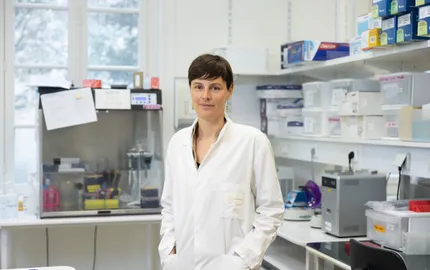Presentation

Our research interest lies in understanding quantitatively how hematopoiesis functions during homeostasis, ageing and infection. To untangle this question, we combine experimental and computational approaches at the single cell level both in mouse and human.
The blood system is composed of diverse, functionally distinct cell types that specialize in different functions: immune responses, oxygen transport and clotting. During adulthood, these diverse cell types originate from hematopoietic stem cells though a process called hematopoiesis. As most hematopoietic cells are short-lived, hematopoiesis is a constantly regenerating process. Moreover, hematopoiesis flux can vary in response to changing demands for hematopoietic cells in peripheral tissues, for example during bleeding or infection.
Our research interest lies in understanding quantitatively how hematopoiesis functions during homeostasis, ageing and infection. To untangle this question, we combine experimental and computational approaches at the single cell level both in mouse and human.
We aim at understanding how cell fate decision occurs during hematopoiesis and what influence these decisions. We have shown that the decision to produce red blood cells and myeloid cells occurs earlier in the process than previously thought, in the multi-potent compartment (Perié et al, Cell 2015). Similarly, we have found an alternative path of production of dendritic cells (DCs), directly from multipotent progenitors, independent but complementary to their already known lymphoid and myeloid origin (Naik S et al, Nature 2013; Perié et al, Cell Reports 2014).
We are also characterizing cell dynamics at the single cell level to understand how hematopoiesis is organized as a system and respond to changing demands for cells. Using an ex vivo method that enables simultaneous determination of common ancestor, division number, and differentiation status of a large collection of single cells, we have shown that cells that derived from a common ancestor had significant similarities in their division progression and differentiation outcomes (Tak et al, elife 2021). These results point at the importance of common ancestor effects and inherited cellular memory of cell decision to divide or differentiate.
Our research aims at developing new single cell lineage tracing methodologies (genealomics) to study hematopoiesis not only in mice but also in humans. We have established several experimental and computational genealomic tools to follow the descendant of single cell and track their destiny (Perié et al, FEBS 2016; Lyne et al, Exp Hematol 2018).
Keywords: single cell, cell fate, cellular barcoding, lineage tracing, quantitative biology, hematology, immunology, cell dynamics, genealomics, in situ barcoding.
Learning more about the team :


























